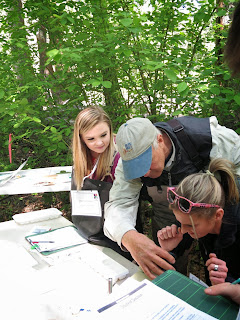Continuing in the tradition of the last few years of
AmeriCorps blogs- I’m here to talk about snow! While the aforementioned element
of fire has strongly affected my life, of equal importance is the element of
water, specifically in the form of snow. As long as I can remember I’ve always
had a deep connection to snow. Winters growing up in the Entiat Valley were
always full of sledding, snowshoeing, and cross country skiing. After my family’s
home burnt down in 1994, we lived in a yurt while re-building on our property.
That was the winter of 1996-97, I was three years old and it snowed upwards of 5
feet. We couldn’t be happier as our yurt turned into an igloo and the landscape
found relief in the added moisture. When I was six years old, my mom woke me up
to show me that it had snowed overnight and I began to cry because I found it
so beautiful. And at 14, I fell in love with the sport of alpine skiing at
Mission Ridge and have been incredibly hooked on the sport since. I can’t quite
put my finger on it; what snow brings that is so magical. Perhaps it is the
peacefulness- the muffling of loud sounds, the necessity of moving slower
through our day’s errands. Perhaps it is the nostalgia of feeling like a child
again- the ageless feeling we get when playing in the snow. For me it is the
coldness of the air that brings a sense of clarity and the endorphins I get
from skiing, hiking, and playing in the snow. And obviously, it is the holidays
that bring us all together- the break from work and school, the importance of
reflection and gratitude we feel during this time of year.
 |
| The percentage of area in drought status is still higher right now that it was one year ago. |
Besides the joyous wonders of a white holiday season- the
effects of a snowy (or dry) winter last long into the summer. Last winter we
saw an incredible lack of snow and the ecological and economic effects of that
hit hard over the summer. The effects of the biggest wildfire ever in our state’s
history led to lack of tourism and loss of important infrastructure. The lack
of water led to a weakness in our defense against those fires, it was hard
hitting on orchardists and farmers, habitat for important species suffered, the
list goes on and on. Although we are
still currently in a drought- the Department of Ecology recently stated that the
Drought Emergency Declaration will be ending at the end of the year due to snow
levels being at or above 100% of normal for this time of year. For the
emergency declaration to be made water supply levels must be below 75%. The month
of December has been so good to our area with snow falling up high and a
mixture of rain and snow falling down low. I am eager to see where this El Nino
season takes us and am hoping that the trend of snow continues. And if it does,
I am eager to see the effects of that come summertime.
 |
| Our region is currently at 126% of normal snow water equivalent. |
As a person whose happiness strongly depends on the ability
to ski in the winter months I will say that I’ve learned to do it while you
can. Mission Ridge is at ~70 inches of snowfall for the month, close to their
~100 inch December snowfall record. Who knows what the rest of the season will
bring us- hopefully more of the same, but possibly not. Until it changes, that’s
where you’ll find me (and a few others from the Cascadia office)!
As always thanks for stopping by, on behalf of the Cascadia
staff, we wish you a very joyous holiday season! Let me know in the comments what
your favorite part of a snowy holiday season is!
-McKenzie
ftp://ftp.wcc.nrcs.usda.gov/data/water/wcs/gis/maps/wa_swepctnormal_update.pdf
http://www.ecy.wa.gov/drought/index.html
http://droughtmonitor.unl.edu/Home/StateDroughtMonitor.aspx?WA













.JPG)
.JPG)
.jpg)







.jpg)






_(2).jpg)

.jpg)
.jpg)

.jpg)

.jpg)


